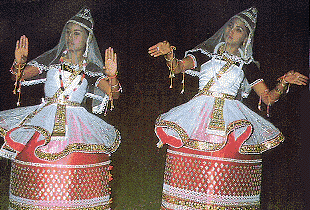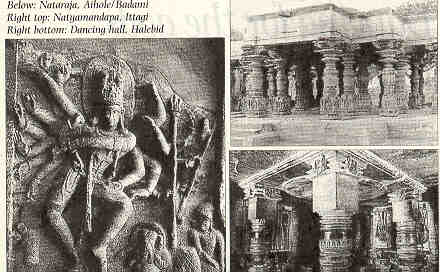|
|
Manipuri
|
| Manipur is a beautiful valley, located in the North East of India. The important
items in the repertoire of Manipuri are Ras dances, of which there are four main
types which pertain to Krishna and are performed only by women and girls. Lyrical grace,
lightness or delicacy of hand gestures set Manipuri apart from the geometric structure of
Bharatanatyam and the linear quality of Kathak. The costumes and ornaments in Ras
are colourful and glittering.

Apart from the graceful Ras dances, Manipuri has another form called Choloms.
These are vigorous Tandava items in which the dance jumps, leaps and while on floor
while marking the rhythm on the drum slung from his neck. Important in this category are
the Poong Cholom, danced by men holding drums and the Kartal cholom, performed by
men or women with cymbals in their hands. The choloms are all part of the Sankeertana
of Manipuri, a tradition of singing and dancing directed towards achieving union with Lord
Krishna. |
|
|
|
|
| |
|
|
|
|
|
 Indian Classical Dances
Indian Classical Dances
India has one of the richest cultural heritages in the
world. Its classical dance traditions date back 2000 years. Indian classical dance is a
synthesis of many arts.
 Bharathanatyam
Bharathanatyam
This dance which originated in the temples of TamilNadu,
specially from Tanjore and Chidambaram, was performed by Devadasi's in the olden days.
Graceful movements, mime, and music contribute in equal measure to this beautiful dance
from the South. The distinguishing features of "Bharat Natyam" are the noble,
almost geometrical angularity of movements and forceful foot-work.
 Mohiniyattam
Mohiniyattam
Mohini Attam or the dance of the Enchantress, originated in
the Southern most state of Kerala. This dance, unlike the other 2 South Indian styles, has
wide and swaying movements of the body and 15 more sensuous in style.
 Kathakali
Kathakali
One of the major Dance drams styles of India, has originated
from the lush, green Southern most state of India - Kerala. A traditional Kathakali
performance lasts all night and tells stories of heroes and heroines, Gods & Demons
from the Indian epics, Mahabharata and Ramayana. The techniques of Kathakali are extermly
complicated and the dancers, mainly men, excute rapid spins, leaps and freezes with split
second timings.
 Odissi
Odissi
Orissa, on the Eastern Sea-Coast of India, is the home of
the highly sensuous and lyrical form of dance called Odissi. This state is famous for its
temples, the Konarak, dedicated to the Sun God, The Jagannath Temple of Puri and many
more. The main features of this dance are its postures and sculpturous positions, closely
relating to the sculptures of the famous temples of Orissa. The Odissi dancer bends the
hips and sways the torso in curves and flexions known as "Tribhangi" (Triple
Bend) and "Atibhangi" (Semi-circular bend) from the torso downwards.
 Kathak
Kathak
A major solo style of Northern India, Kathak has
traditionally been danced by both men and women. This dance originated from the Braj
region in Uttar Pradesh by "Kathakars" or story tellers. With the advent of
Moghals in the North, Kathak moved from the temples to the courts or darbars of the Kings.
Thus this is the only dance where there is fusion of Hindu & Muslim culture. The
distinctive feature of Kathak is its brilliant foot-work, and an even motion with a rapid
tempo, the beauty and grace of movement is retained.
 Kuchipudi
Kuchipudi
Similar in many ways to BharatNatyam, this dance style which
originated as a ballet form of dance, from the village named Kuchupudi in AndhraPradesh,
has its own distinctive music and a more plastic or fluid line. It is only in recent times
that Kuchupudi has began to be performed solo and by Women.
 Manipuri
Manipuri
Manipur is located in the North Eastern part of Indian,
surrounded by mountain ranges, is famous for Manipuri dances, which is mainly devotional.
Lyrical grace, lightness of tread and delicacy of hand gestures, set Manipuri dance apart
from the geometric structure of BharatNatyam and the linear quality of Kathak. There are
also some vigorous Thadava or Musculine items called Cholam, in which the dancer leaps,
whirls and spins on the floor, while keeping rhythm on the drums slung from his neck.
 Links
Links
Here you will find a lot of other web sites related to
Indian Classical Dances. We really appreciate for visiting us.